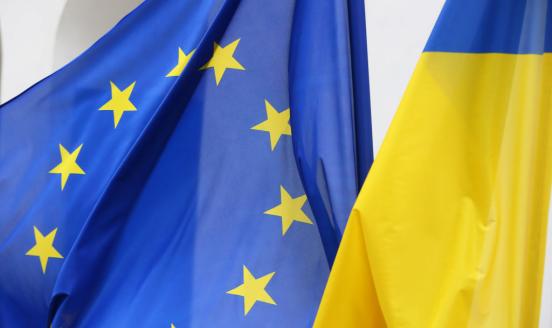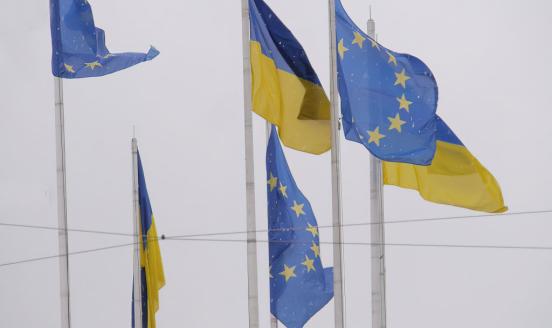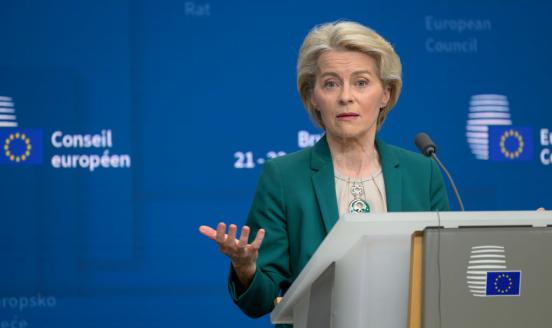Euro-area enlargement: a new opening?
8 of the EU27 have not yet joined the Euro, and progress in euro-area enlargement seems to have stalled. Commission President Juncker wants to give ne

In his State of the Union speech on 13 September, European Commission president Jean-Claude Juncker raised the prospect of further enlargement of the euro area. He noted that all EU countries – apart from Denmark and the United Kingdom, which have opt-outs – are “required and entitled to join the euro once they fulfil all conditions”. He even proposed the idea of a “Euro-accession Instrument” that would offer “technical and even financial assistance” to the current non-euro countries.
Juncker provided no detail about the possible Euro-accession Instrument. But his comments were a reminder that the process of euro-area enlargement has come to a halt since Lithuania joined the single currency at the start of 2015. In adopting the euro, Lithuania joined six of the countries that have joined the EU since 2004: Slovenia (adopted the euro in 2007), Cyprus (2008), Malta (2008), Slovakia (2009), Estonia (2011) and Latvia (2014). However, there are no new candidates actively moving in this direction.
The European Exchange Rate Mechanism (ERM2), which is a mandatory interim regime for prospective entrants to the Economic and Monetary Union (EMU), currently has only one member – Denmark, which, along with the United Kingdom, has a permanent opt-out in any case. Other ‘outs’ – Bulgaria, Croatia, the Czech Republic, Hungary, Poland, Romania and Sweden – do not have such an opt-out. However, most are not in a hurry to join the common currency[1], for both political and economic reasons.
In terms of politics, there is a reluctance to transfer more national sovereignty to the EU level and to give up the national currencies that are seen as symbols of this sovereignty. In addition, during the euro-area financial crisis of 2010-13, politicians in ‘out’ countries publicly expressed doubts about the sustainability of the euro project, and preferred to take a wait-and-see approach.
The economic arguments for staying out refer, most frequently, to the benefits of exchange rate flexibility based on the optimum-currency area (OCA) theory (see below). Occasionally, there have also been reservations about participation in the European Stability Mechanism (ESM) and other bailout instruments that are aimed at helping the troubled countries of the euro-area periphery.
In some cases (eg Poland before 2015), the stated political and economic reservations have masked a reluctance or inability to do the work necessary to meet the EMU membership criteria, especially on the fiscal and institutional fronts.
On the other hand, the 19 ‘ins’ have not necessarily been enthusiastic about admitting new members to the club. They were preoccupied with the 2010-13 crisis and the reforms aimed at strengthening the economic and institutional architecture of the common currency area. In some cases, they suspected that potential new entrants might not be prepared economically and institutionally to adopt the euro, or that they would not follow the rules once they were accepted. Evidently, fresh memory of the crisis in the euro-area periphery (especially in Greece) and a desire to avoid similar troubles in the future played a role.
EMU enlargement: potential benefits for the EU
From the perspective of the entire EU, three kinds of arguments – political, institutional and economic – should be taken into consideration in the question of potential enlargement of EMU.
Historically, EMU membership proved the most powerful factor in ‘multi-speed’ integration, leading to an increasing degree of internal differentiation between euro ‘ins’ and ‘outs’. This might have had a negative impact in terms of political ownership of EU rules and decisions, undermining solidarity in addressing common challenges, and creating differentiation of economic and political interests (Dabrowski, 2017). For example, during and after the euro crisis, ‘outs’ were rather reluctant to help rescue euro-area countries in trouble and to contribute to the repair of the euro-area architecture. As result, some major reform steps, such as the Fiscal Compact, had to be introduced through intergovernmental treaties outside the existing body of EU law. Other initiatives such as the banking union were limited de facto to euro-area countries, even if it would be desirable that all EU countries join. (Formally the ‘outs’ can join the banking union but none have so far done so; see Hüttl and Schoenmaker, 2016).
Many other economic governance frameworks – the Stability and Growth Pact, Macroeconomic Imbalance Procedure and European Semester – are more intrusive and rigorous with respect to the ‘ins’ than the ‘outs’, even if there is no economic justification for the differentiation. Fiscal, financial or balance-of-payments fragility in any member state could be equally destabilising for the entire EU, regardless of whether a given country uses the euro or its national currency.
This dual economic governance regime can also have a negative impact on the functioning of the EU institutions. The European Commission, Council and European Parliament represent all member states, but some of their decisions only relate to the EMU members. This might lead to conflicts of interest when representatives of ‘outs’ have to take part in deciding on the issues of vital importance for the ‘ins’. They may block the new integration steps within the euro area because they fear marginalisation (see below). On the other hand, ‘ins’ can ignore the side effects their initiatives might have for the ‘outs’.
Since the beginning of the euro-area periphery crisis in 2010, one can observe the increasing role of the Eurogroup, consisting of the euro area’s finance ministers, at the expense of the Economic and Financial Affairs Council (ECOFIN), which is often limited to rubberstamping Eurogroup decisions.
If the euro area integrates further, for example, by adopting a separate euro-area budget or a euro-area budget line within the EU budget, as suggested by Juncker in his State of the Union Address, it would complicate even more the functioning of the EU’s governing bodies, especially the European Parliament, and would result in pressure for separate EMU governing bodies.
Thus, if the current ‘outs’ join EMU, it would substantially reduce the degree of ‘multi-speed’ integration and make the EU more homogenous politically and institutionally.
Economically, a common currency is an integral component of the single market even if, for political reasons, it is considered as a separate integration project, subject to different membership criteria. It reduces cross-border transaction costs by elimination of currency conversion costs and exchange rate risk (European Commission, 1990, Annex A, pp. 251-268). Such costs may be more substantial than some tariff or non-tariff barriers and, therefore, diminish potential trade and investment flows. Furthermore, as long as separate currencies continue to exist within the single market, one cannot rule out intended or unintended competitive devaluation, potentially causing harm to other member states.
The development of the banking union since 2012 has brought new challenges to the single market for financial services, with increasing differentiation between regulatory regimes and degrees of cross-border integration for ‘ins’ and ‘outs’. If the process of establishing the banking union continues, supplemented by deeper capital and labour market integration within the euro area, there will be a risk of formation of a de facto two-tier common market (closer for ‘ins’ and looser for ‘outs’) (Sapir and Wolff, 2016). Again, the EMU enlargement (which also means current ‘outs’ joining the banking union) might reduce this risk.
Apart from single market considerations, the instability of national currencies can also lead to financial crises in ‘outs’ (as happened in 2008-09 in Hungary, Latvia and Romania), with negative implications for the entire EU.
On the negative side, if any country that does not meet accession criteria and is not ready to follow common rules after accession (especially those related to fiscal discipline) is allowed to join the euro area, there will be a risk of new financial turbulence. Therefore, membership criteria cannot be compromised, as happened in the past.
However, the ‘outs’ that do not have permanent opt-outs outperform the euro-area average in most cases, judging by fiscal indicators (Table 1). Their microeconomic elasticity especially with respect to labour markets (as measured by the OECD Employment Protection Index, Table 2) also does not differ and sometimes looks better than the ‘ins’
Should the ‘outs’ join EMU?
The ‘outs’ also have good reasons to think seriously about joining the euro area.
Politically, remaining outside the EMU means risking becoming second-order member states with limited influence over several EU policy decisions determined by the interests of ‘ins’. Furthermore, after Brexit, the bargaining power of euro ‘outs’ in the Council will substantially decrease.
The risk of political marginalisation will further increase if a deeper integration of the euro area goes ahead (see above). Politicians in the ‘outs’ recognise this risk (Bayer, 2017; Reuters, 2017; Shotter, 2017). However, instead of challenging the closer integration of the euro area, ‘outs’ should consider joining it.
Apart from trade and investment creation because of lower transaction costs joining the euro area can strengthen macroeconomic and financial stability in the current ‘outs’. First, it will move monetary policy decisions beyond domestic politics. Second, it will give national central banks access to the ECB’s refinancing facilities, which may be helpful in times of market stress. Third, membership of the banking union will mean, in most cases, tighter regulatory standards enforced by the regulatory authority independent of domestic politics. Finally, adopting the euro will help to reduce the high share of foreign-currency denominated loans in total loans and foreign-currency denominated liabilities in total liabilities, especially in Croatia, Bulgaria and Romania (Table 3).
Even if according to the OCA theory exchange rate flexibility[2] can serve as an adjustment tool in cases of macroeconomic imbalances or idiosyncratic shocks, in the contemporary environment of financial globalisation, exchange rate movements are not always driven by changes in trade and current account balances. More frequently, they respond to changes in global capital flows. That is, for small open economies, exchange rate flexibility will not necessarily deliver the desired direction of exchange rate adjustment in a given period (from the point of view of the trade balance). For the same reason (unrestricted capital movement), central banks in small open economies have limited room to manoeuvre in ‘leaning against wind’, ie conducting interest rate policies that differ from those of major central banks. In the long run, exchange-rate flexibility cannot replace microeconomic flexibility, ie be a substitute for structural reforms[3].
Furthermore, larger-scale currency depreciation can easily damage financial sector stability and the balance sheets of non-financial corporations and households.
No new EMU members in the short term
Even if the current ‘outs’ decide to join euro, it will not happen overnight. Three years would be the minimum transition period, given the requirement to stay in the ERM2 for at least two years. Apart from meeting the five Maastricht nominal convergence criteria and adjusting domestic legislation in relation to their central banks, the potential candidates will have to join the ESM, and banking union, and conduct other reforms to strengthen their economic institutions and increase microeconomic flexibility. This requires a lot of homework. Thus, an accession horizon of five to ten years seems to be realistic in most cases.
In each case, accession decisions and their timetables will depend on domestic politics. The attitude of central and eastern European governments to adoption of the euro differs: it is positive in Bulgaria, Croatia (EUObserver, 2017) and Romania, but ambiguous or negative in the Czech Republic, Hungary and Poland (Bayer, 2017). In Sweden, euro adoption was subject to the referendum held on 14 September 2003, with almost 56 percent of voters saying ‘no’. In Denmark, which possesses the ‘opt-out’ option, a similar referendum held three years earlier (on 28 September 2000) also gave a negative answer (more than 53 percent of voters said ‘no’). Neither Sweden nor Denmark plan to repeat these referendums soon because of the low support for euro membership.
The Euro-accession Instrument proposed in by Juncker will be unlikely to impact the decisions of ‘outs’ on whether join EMU. However, Juncker's intervention can be seen as a change in the attitude of the European Commission (and hopefully also the ‘ins’) about EMU enlargement, and therefore could encourage those ‘outs’ that are willing to adopt the euro to set a concrete accession timetable and move forward with its implementation.
References and footnotes
Bayer, L. (2017) ‘EU divisions on the eastern front’, Politico, 11 October, available at http://www.politico.eu/article/eu-divisions-eastern-integration-romania-bulgaria-croatia-poland-hungary-czech-republic/?utm_source=POLITICO.EU&utm_campaign=221d072141-EMAIL_CAMPAIGN_2017_10_10&utm_medium=email&utm_term=0_10959edeb5-221d072141-189108713
Dabrowski, M. (2017) ‘How to balance sovereignty and integration in a voluntary EU’, Bruegel Blog, 12 January, available at https://bruegel.org/2017/01/sovereignty-integration-voluntary-eu/
Darvas, Z. (2017) ‘Macroeconomic performance of newer EU member states inside and outside the euro area’, presentation to the Bruegel Research Meeting, 26 June
Demertzis, M., K. Efstathiou and F. Matera (2017) ‘The Italian Lira: the exchange rate and employment in the ERM’, Bruegel Blog, 13 January, available at https://bruegel.org/2017/01/the-italian-lira-the-exchange-rate-and-employment-in-the-erm/
EUObserver (2017) ‘Croatia keen to introduce euro in 2022’, EUObserver, Ticker, 10 October, available at https://euobserver.com/tickers/139356
European Commission (1990) ‘One market, one money. An evaluation of the potential benefits and costs of forming an economic and monetary union’, European Economy, Vol.44, available at http://ec.europa.eu/economy_finance/publications/pages/publication7454_…
Hüttl, P. and D. Schoenmaker (2016) ‘Should the ‘outs’ join the European banking union?’ Policy Contribution 2016/03, Bruegel, available at https://bruegel.org/wp-content/uploads/2016/02/pc_2016_03.pdf
Reuters (2017) ‘Polish president says ‘multi-speed’ EU will lead to break-up of bloc’, 5 September, available at https://www.reuters.com/article/us-poland-eu-duda/polish-president-says…
Sapir, A. and G.B. Wolff (2016) ‘One market, two monies: the European Union and the United Kingdom’, Policy Brief 2016/01, Bruegel, available at https://bruegel.org/wp-content/uploads/2016/01/pb-2016_01.pdf
Shotter, J. (2017) ‘Czech foreign minister rebuffs Macron’s EU overhaul push’, Financial Times, 11 October, available at https://www.ft.com/content/553906f6-a9ff-11e7-ab55-27219df83c97?segment…
[1] Immediately upon its EU accession in 2007 Bulgaria, which has had a euro-denominated currency board since 1997, applied to join the ERM2 but was denied by the European Central Bank (ECB).
[2] Bulgaria with its currency board and Croatia with a tightly managed peg to euro cannot benefit from exchange rate flexibility.
[3] See Demertzis et al (2017) on the history of the devaluation of the Italian lira, which did not lead to labour market improvement. Darvas (2017) shows that exchange rate flexibility did not help, on average, new member states to carry out smoother macro- and microeconomic adjustment after the 2008 global financial crisis.



